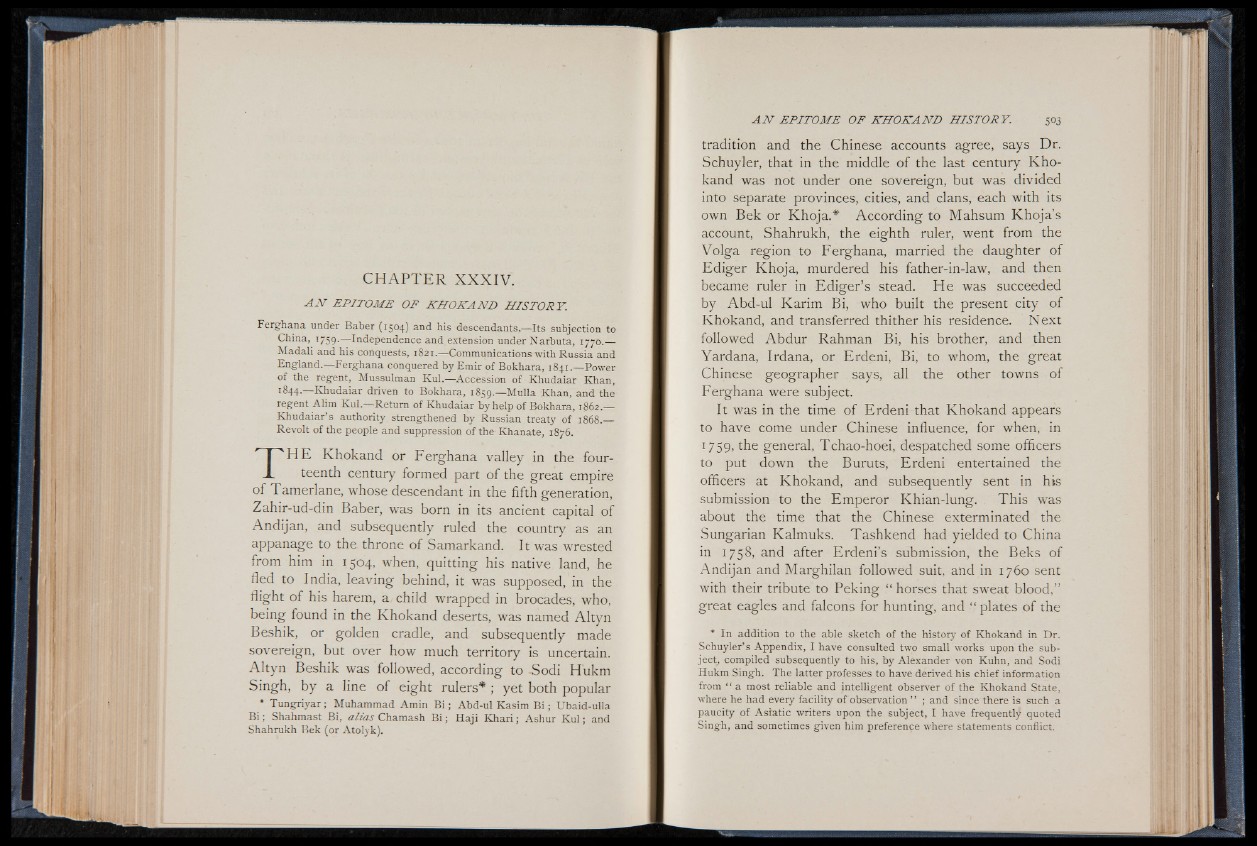
C H A P T E R X X X IV .
A N E P ITOM E OF K H O K A N D H ISTO R Y .
Ferghana under Baber (1504) and his descendants,— Its subjection to
China, 1759.— Independence and extension under N arbuta, 1770.—
Madali and his conquests, 1821.— Communications with Russia and
England.— Ferghana conquered by Emir of Bokhara, 1841— Power
of the regent, Mussulman Kul.— Accession of Khudaiar Khan,
1844.— Khudaiar driven to Bokhara, 1859.— Mulla Khan, and the
regent Alim Kul.— Return of Khudaiar by help of Bokhara, 1862.—
Khudaiar’s authority strengthened by Russian treaty of 1868.—
Revolt of the people and suppression of the Khanate, 1876.
TH E Khokand or Ferghana valley in the fourteenth
century formed part of the great empire
of Tamerlane, whose descendant in the fifth generation,
Zahir-ud-din Baber, was born in its ancient capital of
Andijan, and subsequently ruled the country as an
appanage to the throne of Samarkand. It was wrested
from him in 1504, when, quitting his native land, he
fled to India, leaving behind, it was supposed, in the
flight of his harem, a, child wrapped in brocades, who,
being found in the Khokand deserts, was named Altyn
Beshik, or golden cradle, and subsequently made
sovereign, but over how much territory is uncertain.
Altyn Beshik was followed, according to -Sodi Hukm
Singh, by a line of eight rulers* ; yet both popular
* Tun gr iy a r; Muhammad Amin B i ; Abd-ul Kasim B i ; Ubaid-ulla
B i ; Shahmast Bi, alias Chamash B i ; Haji K h a r i; Ashur K u l ; and
Shahrukh Bek (or Atolyk).
tradition and the Chinese accounts agree, says Dr.
Schuyler, that in the middle of the last century Khokand
was not under one sovereign, but was divided
into separate provinces, cities, and clans, each with its
own Bek or Khoja.* According to Mahsum Khoja’s
account, Shahrukh, the eighth ruler, went from the
Volga region to Ferghana, married the daughter of
Ediger Khoja, murdered his father-in-law, and then
became ruler in Ediger’s stead. He was succeeded
by Abd-ul Karim Bi, who built the present city of
Khokand, and transferred thither his residence. Next
followed Abdur Rahman Bi, his brother, and then
Yardana, Irdana, or Erdeni, Bi, to whom, the great
Chinese geographer says, all the other towns of
Ferghana were subject.
It was in the time of Erdeni that Khokand appears
to have come under Chinese influence, for when, in
1759, the general, Tchao-hoei, despatched some officers
to put down the Buruts, Erdeni entertained the
officers at Khokand, and subsequently sent in his
submission to the Emperor Khian-lung. This was
about the time that the Chinese exterminated the
Sungarian Kalmuks. Tashkend had yielded to China
in 1758, and after Erdeni’s submission, the Beks of
Andijan and Marghilan followed suit, and in 1760 sent
with their tribute to Peking “ horses that sweat blood,”
great eagles and falcons for hunting, and “ plates of the
* In addition to the able sketch of the history of Khokand in Dr.
Schuyler’ s Appendix, I have consulted two small works upon the subject,
compiled subsequently to his, by Alexander von Kuhn, and Sodi
Hukm Singh. The latter professes to have derived his chief information
from “ a most reliable and intelligent observer of the Khokand State,
where he had every facility of observation ” ; and since there is such a
paucity of A siatic writers upon the subject, I have frequently quoted
Singh, and sometimes given him preference where statements conflict.